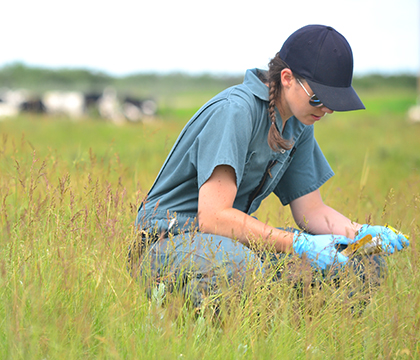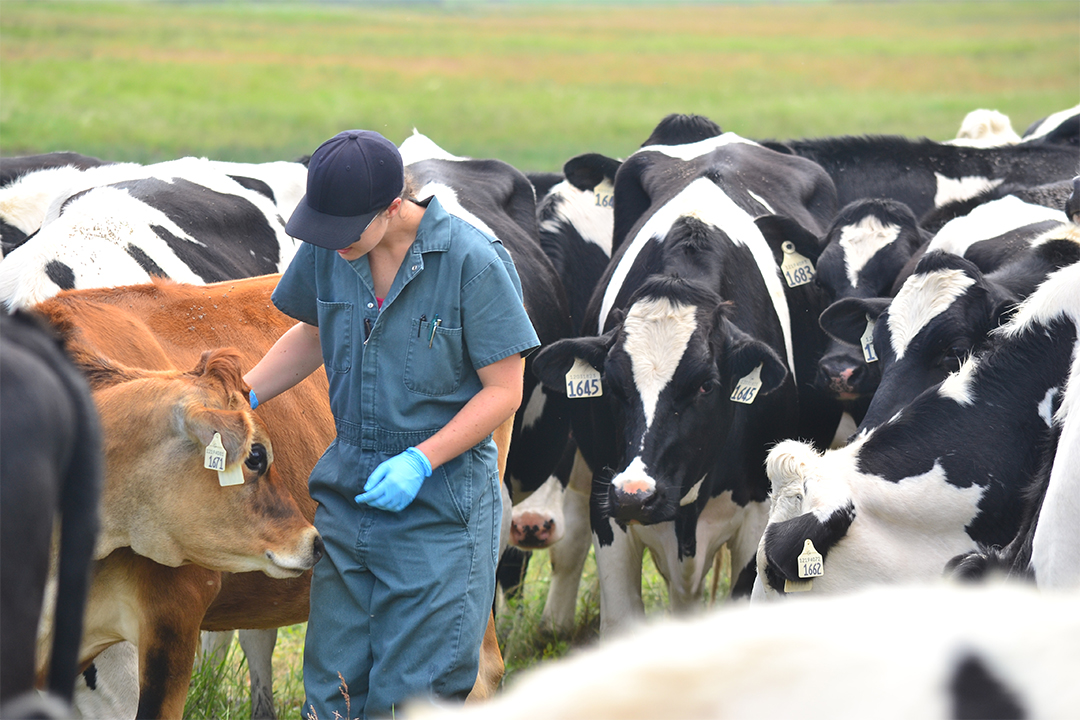Scott's interest in cattle stems from growing up on a beef farm near Lacombe, Alta. Now a graduate student pursuing a Master of Science (MSc) degree at the WCVM, she's part of a research group that's investigating the prevalence of gastrointestinal nematodes – parasites – in Saskatchewan dairy cattle.
Gastrointestinal nematodes are present in dairy cattle worldwide, and their negative impact on production in dairy herds has been well documented. They result in large economic losses and although recent information is lacking, it has been estimated that parasites cost the U.S. cattle industry $2 billion a year due to lost productivity. Scott and her research team are working to obtain baseline data about the number and species of gastrointestinal nematodes present in Saskatchewan dairy heifers of breeding age. They're evaluating heifers on six farms that are being pastured for the summer.
The cost of raising heifers is one of the largest expenses for a dairy operation. Since these animals have a developing immune system and no previous exposure to parasites, they're at an increased risk of developing parasitic infection. These infections can also affect their growth rate, affecting their lifetime productivity.
 In the past, producers have used anthelmintic drugs (dewormers) to control parasite loads in their animals, but there are increasing reports of anthelmintic resistance that's affecting livestock industries worldwide. Recent data from the U.S. indicates that internal parasites in beef cattle are developing resistance to ivermectin and benzimidazoles, the most commonly used anthelmintic drugs.
In the past, producers have used anthelmintic drugs (dewormers) to control parasite loads in their animals, but there are increasing reports of anthelmintic resistance that's affecting livestock industries worldwide. Recent data from the U.S. indicates that internal parasites in beef cattle are developing resistance to ivermectin and benzimidazoles, the most commonly used anthelmintic drugs.
"With the looming threat of anthelmintic resistance, it is important for producers to understand the risks of parasitism and the opportunities and benefits of managing herds to slow the spread of resistance," says Scott.
Since there's no information on the prevalence of gastrointestinal nematodes in Saskatchewan dairy herds, it's difficult to evaluate the presence or the extent of anthelmintic resistance in the region or even to know to what extent and with what parasite species dairy heifers are infected with.
Given the well-documented impact of internal parasite burden on cattle health and production as well as the increase in anthelmintic drug resistance, it's critical for researchers to close this knowledge gap.
Once researchers have determined the level of parasitism and anthelmintic resistance that exists in growing dairy heifers in Western Canada, dairy producers can act on that information.
By developing economically sound and sustainable control practices, they can decrease the impact of internal parasites on production and limit the development of anthelmintic resistance.
Traci Henderson of Gainsborough, Sask., is a third-year veterinary student. Her research was funded by the WCVM Interprovincial Summer Student Research Program. Traci's story is part of a series of articles written by WCVM summer research students.
Gastrointestinal nematodes are present in dairy cattle worldwide, and their negative impact on production in dairy herds has been well documented. They result in large economic losses and although recent information is lacking, it has been estimated that parasites cost the U.S. cattle industry $2 billion a year due to lost productivity. Scott and her research team are working to obtain baseline data about the number and species of gastrointestinal nematodes present in Saskatchewan dairy heifers of breeding age. They're evaluating heifers on six farms that are being pastured for the summer.
The cost of raising heifers is one of the largest expenses for a dairy operation. Since these animals have a developing immune system and no previous exposure to parasites, they're at an increased risk of developing parasitic infection. These infections can also affect their growth rate, affecting their lifetime productivity.
 In the past, producers have used anthelmintic drugs (dewormers) to control parasite loads in their animals, but there are increasing reports of anthelmintic resistance that's affecting livestock industries worldwide. Recent data from the U.S. indicates that internal parasites in beef cattle are developing resistance to ivermectin and benzimidazoles, the most commonly used anthelmintic drugs.
In the past, producers have used anthelmintic drugs (dewormers) to control parasite loads in their animals, but there are increasing reports of anthelmintic resistance that's affecting livestock industries worldwide. Recent data from the U.S. indicates that internal parasites in beef cattle are developing resistance to ivermectin and benzimidazoles, the most commonly used anthelmintic drugs."With the looming threat of anthelmintic resistance, it is important for producers to understand the risks of parasitism and the opportunities and benefits of managing herds to slow the spread of resistance," says Scott.
Since there's no information on the prevalence of gastrointestinal nematodes in Saskatchewan dairy herds, it's difficult to evaluate the presence or the extent of anthelmintic resistance in the region or even to know to what extent and with what parasite species dairy heifers are infected with.
Given the well-documented impact of internal parasite burden on cattle health and production as well as the increase in anthelmintic drug resistance, it's critical for researchers to close this knowledge gap.
Once researchers have determined the level of parasitism and anthelmintic resistance that exists in growing dairy heifers in Western Canada, dairy producers can act on that information.
By developing economically sound and sustainable control practices, they can decrease the impact of internal parasites on production and limit the development of anthelmintic resistance.
Traci Henderson of Gainsborough, Sask., is a third-year veterinary student. Her research was funded by the WCVM Interprovincial Summer Student Research Program. Traci's story is part of a series of articles written by WCVM summer research students.
Share this story
